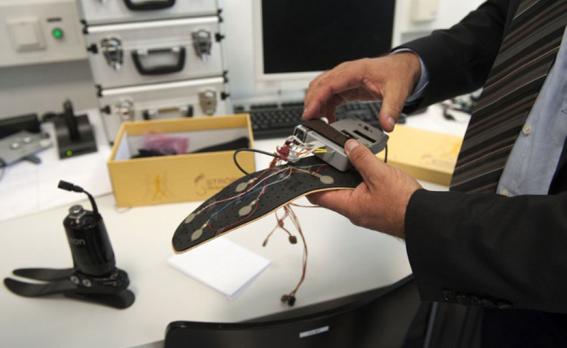
AFP
VIENNA — The world’s first artificial leg capable of simulating the feelings of a real limb and fighting phantom pain will be unveiled by researchers in Vienna.
The recent innovation is the result of a twofold process, developed by Professor Hubert Egger at the University of Linz in northern Austria.
Surgeons first rewired remaining foot nerve endings from a patient’s stump to healthy tissue in the thigh, placing them close to the skin surface.
Six sensors were then fitted to the foot sole of a lightweight prosthesis, and linked to so-called stimulators inside the shaft where the stump sits.
“It’s like a second lease of life, like being reborn,” Austrian amputee Wolfgang Rangger, told AFP.
The former teacher, who lost his right leg in 2007 after suffering a blood clot caused by a cerebral stroke, has spent the last six months testing the new prosthesis.
“It feels like I have a foot again. I no longer slip on ice and I can tell whether I walk on gravel, concrete, grass or sand. I can even feel small stones,” he said.
The 54-year-old also runs, cycles and goes climbing. When he moves, the limp is barely noticeable.
Every time Rangger takes a step or applies pressure, the small sensor devices send signals to the brain.
“In a healthy foot, skin receptors carry out this function but they are obviously missing here. However, the information conductors — the nerves — are still present, they’re just not being stimulated,” Egger said.
“The sensors tell the brain there is a foot and the wearer has the impression that it rolls off the ground when he walks. All things considered, the procedure is a very simple one given the results.”
This is not the first time the Austrian scientist has caused a stir with his research.
In 2010, he presented a mind-controlled prosthetic arm, which the user directed with motor neurons previously connected to the lost limb.
For the artificial leg, the principle remains the same except that the process works in reverse: information is guided from the prothesis to the brain, rather than the other way around.
No more morphine
In addition to increasing balance and safety, the prosthesis provides another remarkable function: it has helped eradicate the excruciating pain Rangger had experienced for years following his amputation.
“I was barely able to walk with a conventional prosthesis, didn’t sleep for more than two hours a night and needed morphine to make it through the day,” he recalled.
But within days of undergoing the operation last October, the pain vanished.
As Egger points out, phantom pain occurs because the brain gets increasingly sensitive as it seeks information about the missing limb.
“Plus the amputation is often tied to a traumatic experience like an accident or illness, and the mind keeps reliving these memories,” he noted.
The advantage of the “feeling prosthesis” is that the brain once again receives real data and can stop its frantic search.
“Rangger is a very different person now to the one I met in 2012,” Egger said.
The two men were introduced to each other at a support group for amputees.
“It struck me that he never laughed and he had these dark rings under his eyes. It was awful.”
Importantly, post-surgery recovery is quick and there are no known health dangers associated with the intervention, he added.
“The only risk is that the nerves don’t reconnect properly and the feelings fail to return,” he said.
With the new technology ready, Egger now hopes that small companies will join his venture and start building the prosthesis to help bring down the market price.
At the moment, a high-tech foot model costs between 10,000 euros ($11,240) and 30,000 euros.
Egger believes his latest project could vastly improve quality of life for amputees, including in developing countries.
“People with amputations aren’t patients in the traditional sense, they aren’t sick — they’re just missing a limb,” he said.
“By giving them back mobility, they also regain their independence and are able to reintegrate into society. That’s what I work for.”
Latest News
-
 Syria monitor says US strikes killed at least five Daesh members
Syria monitor says US strikes killed at least five Daesh members
-
 Jordan welcomes lifting of US sanctions on Syria
Jordan welcomes lifting of US sanctions on Syria
-
 King hails Nashama achievement, Jordanians’ unity, resilience
King hails Nashama achievement, Jordanians’ unity, resilience
-
 Jordan finish runners-up after extra-time loss to Morocco in Arab Cup final
Jordan finish runners-up after extra-time loss to Morocco in Arab Cup final
-
 Egypt emphasizes 'Israel' gas deal is "purely commercial"
Egypt emphasizes 'Israel' gas deal is "purely commercial"